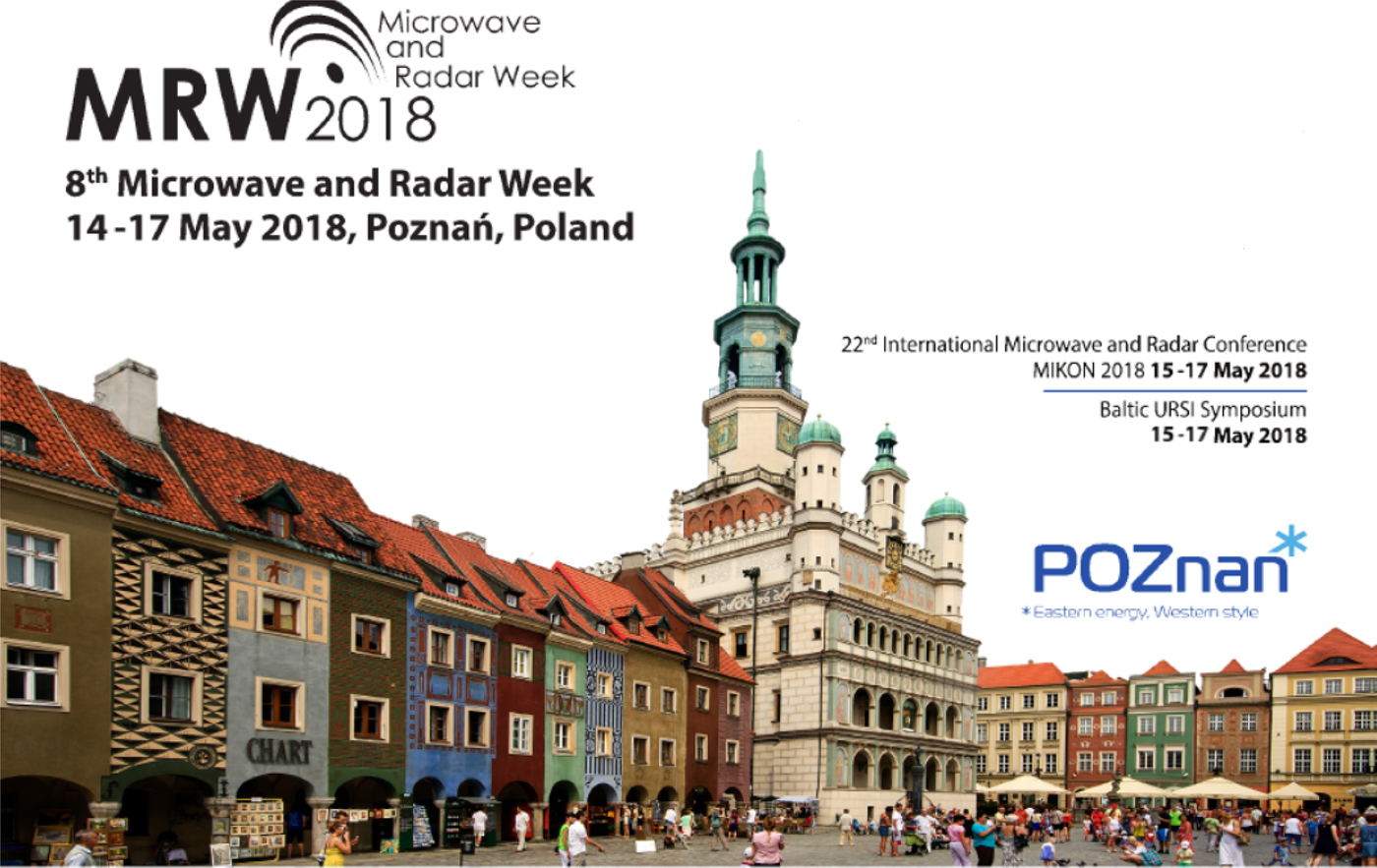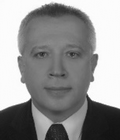
The 22nd International Microwave and Radar Conference (MIKON) 2018 was held in Poznan, the capital city of the Greater Poland region, on May 14–17, 2018. MIKON conferences have a long tradition of over 50 years and are constantly organized under the auspices of the Polish Academy of Sciences (PAN). In 1994, MIKON was transformed into a biennial international conference co-sponsored by the Institute of Electrical and Electronics Engineers (IEEE) and since 2002 also by the European Microwave Association (EuMA) and the European GAAS Association. Over the years, MIKON has become one of the major European conferences in the field of microwave, radar and wireless communication that brings together many experts from the above-mentioned areas.
MIKON 2018 was organized by the MIKON Foundation and by the Warsaw University of Technology as the main conference of the 8th Microwave and Radar Week (MRW) 2018. The second conference within the MIKON 2018 was the 2018 Baltic URSI Symposium. MIKON 2018 was chaired by Professor Krzysztof Kulpa, and the chairman of MRW 2018 was Professor Józef Modelski. The total number of MRW 2018 participants was 375, representing 29 countries around the world. In all, 309 papers (211 – MIKON, 98 – URSI) were presented during 54 topical oral sessions and three poster sessions. Additionally, seven keynote speeches were delivered. The sessions concerned, among others, such aspects as antennas and antenna arrays, passive and active RF and microwave components, electromagnetic field theory, numerical techniques and simulations, microwave measurements, 5 G technologies and networks, passive radars, noise radars, radar imaging, radar signal processing, tracking, direction of arrival techniques, RCS measurements, radio astronomy and space technologies, infrared and terahertz technologies, photonics, and computer vision. Moreover, four tutorials on high-efficiency RF and microwave power amplifiers, aperture synthesis in radar technologies, 5 G technologies, and noise in linear circuits were held during the conference.
This Special Issue of the International Journal of Microwave and Wireless Technologies published by Cambridge University Press gathers the majority of the best technical outcomes from MIKON 2018. The authors of the best 24 papers presented at MIKON 2018 were requested to submit extended versions of their papers to the International Journal of Microwave and Wireless Technologies, and 15 contributions were submitted. These works went through the additional review process according to the high-standard rules of the International Journal of Microwave and Wireless Technologies. Finally, seven of those papers were found suitable for publication in this Special Issue.
The papers published in the Special Issue cover a broad range of advances in the microwaves and radar technologies. The first two papers are devoted to the still-current topic of improvement of the efficiency of microwave power amplifiers. The first paper [Reference Góralczyk and Wojtasiak1] focuses on the design of power amplifiers using a harmonic tuning method. The approach to designing and tuning of a power amplifier presented in the paper allowed the authors to achieve the output power of the amplifier to be 30% greater than the value specified by the manufacturer of the transistor used in the amplifier, providing still high gain and high power efficiency. The authors proved that the harmonic tuning method can be a very effective tool for designing power amplifiers even in the case of its high sensitivity to inaccuracies of both the transistor and microstrip circuit models. The second paper [Reference Jędrzejewski, Rosołowski and Wojtasiak2] presents the results of research on the combination of digital predistortion (DPD) technique with the corresponding choice of DC operating condition of GaN HEMT transistors used in power amplifiers in order to improve their linearity and power efficiency with simultaneous control of adjacent channel leakage (ACLR) and in-band error vector magnitude (EVM) in systems operating with high peak-to-average power ratio (PAPR) and wide bandwidth. The authors indicate that the design of high-performance power amplifiers for the modern wireless systems requires the dedicated optimization of the transistor bias condition so that the usage of DPD provides the best improvement of the amplifier linearity and power efficiency. The third paper [Reference Kuznetsov, Temchenko, Miloserdov and Voskresenskiy3] is devoted to the application of a method based on compressive sensing to near-field diagnosis of active phased antenna arrays. The authors propose two modifications related to two main disadvantages of this method, i.e. to the sensitivity to thermal instability of active elements of an array and to the low accuracy of excitation reconstruction. The subsequent two papers concern two dynamically developing research directions in the field of radiolocation: passive radars and noise radars. The first one, i.e. the fourth paper of the issue [Reference Barkhatov, Vorobev, Veremyev and Kutuzov4], presents the passive radar exploiting DVB-T2 transmitters as illuminators of opportunity, with a two-dimensional non-equidistant antenna array, capable of three-dimensional targets localization. The paper includes the results of preliminary three-dimensional field measurements of UAVs position obtained by the passive radar in which the receiving antenna array was built of low-cost commercially available DVB-T/T2 antennas. The authors of the following paper [Reference Wasserzier and Galati5] propose and discuss the computationally efficient range−Doppler processing algorithm called range filter bank to be used in noise radars with continuous emission. The experimental verification of the algorithm was conducted using an X-band noise radar demonstrator. In the next paper [Reference Djaja-Josko, Kolakowski and Modelski6], a novel approach for simplifying synchronization of anchor nodes in a time differences of arrival (TDOA)-based ultrawideband localization system is presented. The proposed idea is to use pairs of anchor nodes in the localization system instead of individual nodes, and to synchronize only two nodes that make up a pair. The results of simulation and experiments obtained for the wired and wireless synchronization between the nodes are presented and discussed in the paper. The last paper [Reference Kozłowski, Kurek, Skarzynski, Szczygielska and Darmetko7] is one of many papers presented during MRW 2018 that are related to space technology. The paper deals with a concept of adaptive communication with low Earth orbit (LEO) satellites. The proposed adaptive mechanism is based on changing the modulation scheme and convolutional code rate according to the current propagation channel conditions. The adaptation mechanism was tested using the model of the communication system built by means of Universal Software Radio Peripheral (USRP) devices.
As Associate Editors, we would like to thank all the authors for accepting our invitation to submit their works to this Special Issue of the International Journal of Microwave and Wireless Technologies, and taking the effort of preparing the very interesting and valuable extended papers. We also thank all the reviewers for their thorough and careful evaluation of the papers and valuable and constructive comments and suggestions, which helped the authors to improve the quality of the papers. We are very grateful to the Editors-in-Chief of the International Journal of Microwave and Wireless Technologies, i.e. the previous Editor-in-Chief Professor Almudena Suárez, who started the work on this Special Issue and to the current Editor-in-Chief Professor Francisco Medina who helped us to finish this work successfully.
 Konrad Jędrzejewski received M.Sc. degree in electronics and telecommunications and Ph.D. degree in electronics in 1995 and 2000, respectively, from the Faculty of Electronics and Information Technology, Warsaw University of Technology (both with honours). He received D.Sc. degree in electronics in 2014, and Professor of Warsaw University of Technology in 2019. Since 2000, he has been with the Institute of Electronic Systems at the Faculty of Electronics and Information Technology of Warsaw University of Technology. He teaches undergraduate courses on signal processing and information theory, and graduate courses on adaptive signal processing, statistical inference and statistical methods in data science. His main research interests include statistical and adaptive signal processing, analog-to-digital (A/D) converters, especially converters employing adaptive algorithms for A/D conversion, adaptive measurement and telecommunications systems, and radar signal processing. Professor Konrad Jędrzejewski is a senior member of Institute of Electrical and Electronics Engineers (IEEE), member of Polish Information Processing Society (PTI), member of Polish Society for Measurement, Automatic Control and Robotics (POLSPAR), expert of National Centre for Research and Development (NCBR). He is a member of the Editorial Board in ACTA IMEKO, section editor in International Journal of Electronics and Telecommunications, and associate editor in International Journal of Microwave and Wireless Technologies (Cambridge). Since March 2019, he is a Vice-chair of Poland Chapter of IEEE Signal Processing Society.
Konrad Jędrzejewski received M.Sc. degree in electronics and telecommunications and Ph.D. degree in electronics in 1995 and 2000, respectively, from the Faculty of Electronics and Information Technology, Warsaw University of Technology (both with honours). He received D.Sc. degree in electronics in 2014, and Professor of Warsaw University of Technology in 2019. Since 2000, he has been with the Institute of Electronic Systems at the Faculty of Electronics and Information Technology of Warsaw University of Technology. He teaches undergraduate courses on signal processing and information theory, and graduate courses on adaptive signal processing, statistical inference and statistical methods in data science. His main research interests include statistical and adaptive signal processing, analog-to-digital (A/D) converters, especially converters employing adaptive algorithms for A/D conversion, adaptive measurement and telecommunications systems, and radar signal processing. Professor Konrad Jędrzejewski is a senior member of Institute of Electrical and Electronics Engineers (IEEE), member of Polish Information Processing Society (PTI), member of Polish Society for Measurement, Automatic Control and Robotics (POLSPAR), expert of National Centre for Research and Development (NCBR). He is a member of the Editorial Board in ACTA IMEKO, section editor in International Journal of Electronics and Telecommunications, and associate editor in International Journal of Microwave and Wireless Technologies (Cambridge). Since March 2019, he is a Vice-chair of Poland Chapter of IEEE Signal Processing Society.
 Frank Weinmann received the diploma degree in physics from the University of Karlsruhe, Germany, in 1999, and the Dr.-Ing. degree in electrical engineering in 2004 from the same university. Since 2004 he is with the Fraunhofer FHR Research Institute for High Frequency Physics and Radar Techniques in Wachtberg, Germany, as a Research Engineer. In 2009, he became Teamleader of the Electromagnetic Modelling Group and since 2017 he is head of the department of Antenna Technology and Electromagnetic Modelling. Dr. Weinmann's major areas of interest include propagation modeling of electromagnetic waves, high-frequency asymptotic techniques, and RCS studies. He has developed a ray-tracing code based on Shooting-and-Bouncing-Rays (SBR), Physical Optics (PO), and Physical Theory of Diffraction (PTD), which is successfully applied, e.g., for prediction of radar cross section (RCS), modeling of radar signatures, and studies in the fields of wind turbine scattering as well as automotive radar.
Frank Weinmann received the diploma degree in physics from the University of Karlsruhe, Germany, in 1999, and the Dr.-Ing. degree in electrical engineering in 2004 from the same university. Since 2004 he is with the Fraunhofer FHR Research Institute for High Frequency Physics and Radar Techniques in Wachtberg, Germany, as a Research Engineer. In 2009, he became Teamleader of the Electromagnetic Modelling Group and since 2017 he is head of the department of Antenna Technology and Electromagnetic Modelling. Dr. Weinmann's major areas of interest include propagation modeling of electromagnetic waves, high-frequency asymptotic techniques, and RCS studies. He has developed a ray-tracing code based on Shooting-and-Bouncing-Rays (SBR), Physical Optics (PO), and Physical Theory of Diffraction (PTD), which is successfully applied, e.g., for prediction of radar cross section (RCS), modeling of radar signatures, and studies in the fields of wind turbine scattering as well as automotive radar.




